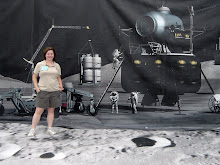
One of the cooler things going on on the Marshall campus (well, ok, except for making ginormous rockets...) is the Lunar Impact Monitoring project. It is part of the NASA Meteoroid Environment Office (MEO) here at MSFC to characterize meteoroid environments for spacecraft engineering and operations. The Automated Lunar and Meteor Observatory (ALaMO) watches dark areas of the moon and looks for bright flashes caused by meteor impacts. ALaMO consists of two telescopes here at MSFC and one in Georgia, all simultaneously monitoring the same area on the Moon. Having the two here allows you to check whether a flash appears in both telescopes to make sure it's not just a random bright pixel on the CCD, like a cosmic ray hit. Having the one in Georgia means you can use parallax to make sure the flash is very far away - glints off of satellites or orbital debris are too close to show up in both states at the same time.
Knowing the meteoroid flux on the Moon and modeling how much debris the impacts kick up is important when you want to build a lunar base, spacesuit, or emergency shelter. If the major danger is from high-velocity primary meteoroid impacts, then you want to have an outer layer of material that takes the brunt of the hit and breaks up the primary so that the inner layer can absorb smaller broken up pieces. But, if there is more danger from the ejecta of these small impacts, the design would be very different and the difference translates to mass and cost uncertainties in design. The present lunar impact flux is also scientifically interesting, as it represents the very small end of the Near Earth Object (NEO) population. The ALaMO sees impacts from roughy fist-sized pieces of debris, most of it already in orbits that intersect the Earth-Moon orbit (NEOs). Extrapolating up to larger sizes is another data point in understanding what debris is nearby our home.
During the lunar eclipse a couple weeks ago, we went out with some local TV crews to talk about the eclipse and general Moon stuff. We intended to use the ALaMO as a backdrop because it looks cool - but the MEO people were there and observing during the eclipse too. Thougheclipses happens during a full, bright moon, which is normally exactly NOT when ALaMO can observe, the few hours of darkness during eclipses enable observation of debris coming from the sunward direction - usually unobservable the rest of the year. How cool is that?

